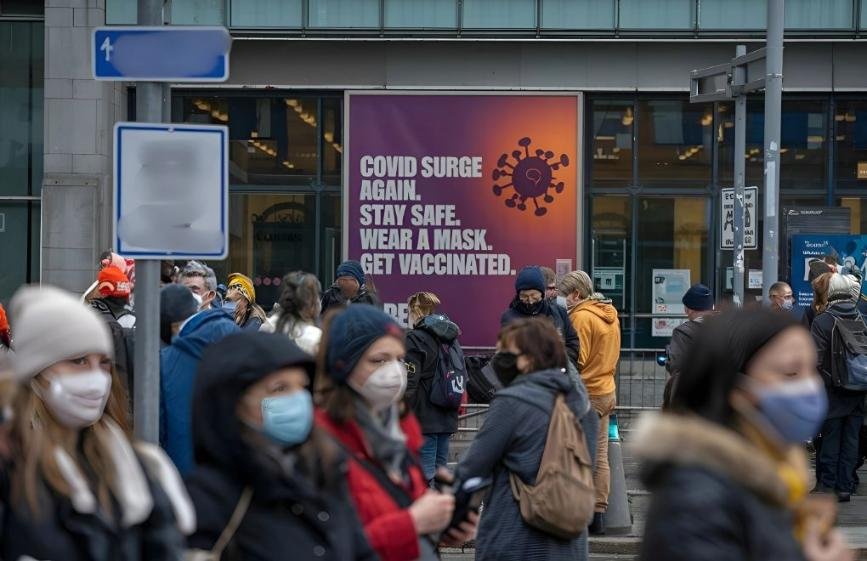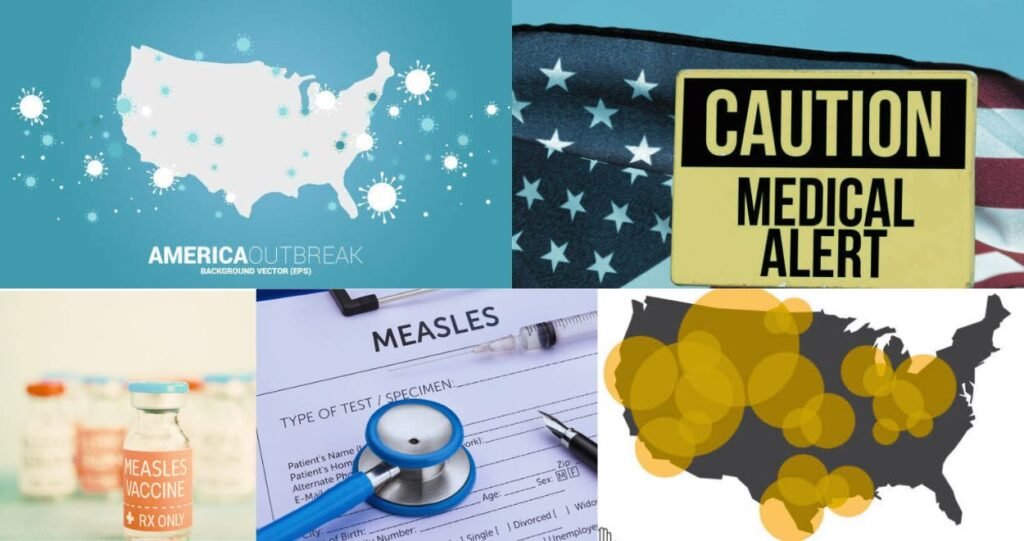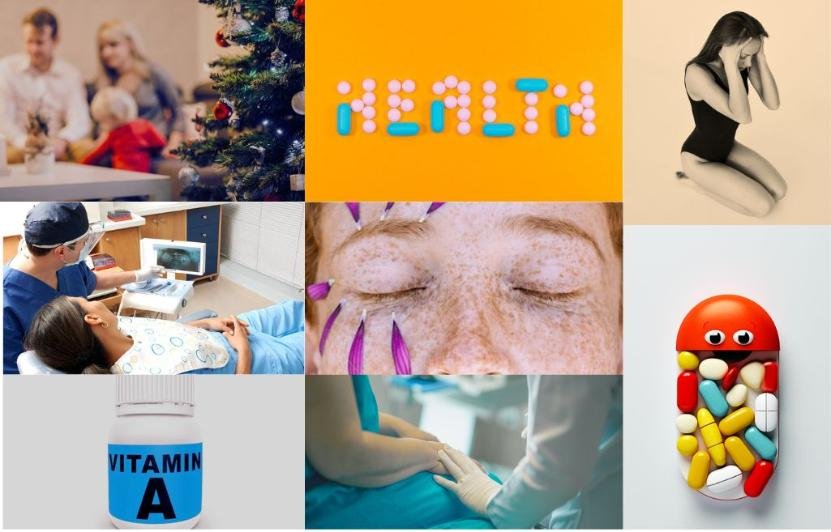Breaking: A viral store Infusing across America! Handle yourself
The United States faces an unprecedented covid revival – which is to re -write a faster epidemiological playbook than scientists, can re -write it again. NB.1.8.1 is growing in China and is now detected in many American states, alarm bells from Seattle to Miami have been triggered. Healthcare system scuffle. Families prepare. The nation stops its breath. This is not just another variant story. It is a wake-up call that is echoing through hospital corridors, class hallways and boardroom meetings across the US. Outbreak like measles that once used to exist the terrorist communities before vaccines, this Kovid wave bears the ability to reopen our understanding of viral transmission dynamics. What needs to be focused on? Everyone. Absolutely everyone.
This article considers the general public as the primary audience and community leaders as the secondary audience. Health-conscious individuals and decision-makers of different groups can also benefit from reading this article.
The Geographic Battlefield: Where COVID Hits the Hardest
Imagine this: America’s COVID landscape is like a complicated game of chess where the virus skitters randomly from place to place. The explosion rate of transmission appears in coastal cities – as imagined the New York Metro system turns into viral highways. Meanwhile, Midwestern cities see slow but persistent upticks, like the beat of a drum of infection that never really ceases.
Southern states? They’re facing a paradox. Houston hospitals are spiking while rural Texas counties are surprisingly flat. It’s astonishing. Northern states take more aggressive actions, putting up guardrails that seem to be working. sometimes. Weather, population, local laws—everything contributes. Nothing is predictable.
Each area of the country has its own viral story, painted in data points that spike and fall daily like stocks.
(I) Variant Dynamics: The NB.1.8.1 Phenomenon
Meet Your New Viral Arch-Nemesis
NB.1.8.1 is the latest COVID-19 variant taking the U.S. and Europe by storm, and it’s different from everything that’s come previously. Scientists are scrambling to decode its genetic fingerprint—a complex molecular puzzle that’s altering viral behavior patterns. This isn’t your average seasonal flu variation; it’s an evolutionary leap that’s got even veteran virologists caught off guard.
The Numbers Don’t Lie:
- Classic COVID variants? Predictable transmission patterns
- NB.1.8.1? Spreads 40% more quickly in the densely populated urban areas
- Prior strains necessitated close contact; this one appears to remain airborne longer
- Breakthrough infections among vaccinated populations rising at record levels
Genetic Nightmare or Natural Evolution?
Research facilities across the world are working around the clock, sequencing samples of viruses at record speed. The mutation profile suggests that this variant has more effective immune evasion pathways—imagine a lock-and-key system where the virus has evolved to open locks more effectively. Regular antibodies cannot recognize it. Vaccine effectiveness decreases. The terms of engagement have altered at a central level.
Transmission Features That Contradict Logic
Urban Hotspots Burn Bright: Cities become viral amplifiers with NB.1.8.1 burning through populations like fire in arid forest. Public transport networks, office buildings, entertainment halls—all become perfect incubation chambers. Contact tracing is all but a distant dream when one infected person can potentially infect hundreds within hours.
Youth Vulnerability Paradox: Young adults aged 20-40 have abnormally high rates of infection with normally healthy immune systems. College campuses become viral labs in which social contact creates perfect tempest settings. Young professionals in group office spaces endure cluster outbreaks that cannot be managed by epidemiologists.
The Pediatric Puzzle: Young kids under age 5 exhibit unusual patterns of symptoms that are different from previous COVID presentations. Pediatric emergency rooms experience more unexplained fatigue visits, behavioral changes, and mild respiratory signs that parents initially dismiss as “typical child illness.”
(II) Vaccination Status Impacts Transmission
Booster Strategy Revolution
** Looking for COVID and Flu test kit at home ?
Vaccination strategies quickly change as NB.1.8.1 breaks existing immunity frameworks. Symptoms are the same as those in other variants of COVID-19 and include sore throat, fever, cough, and fatigue, but vaccine effectiveness varies wildly based on timing, health status, and history of infection.
Current Vaccine Environment:
- Formulations changed to specifically target NB.1.8.1
- Booster intervals shortened from 6 months to 4 months for high-risk groups
- Combination vaccines (COVID + flu) show promising early data
- New-generation nasal vaccines enter accelerated clinical trials
The Protection Paradox:
Even the fully vaccinated experience breakthrough infections, though symptoms remain comparatively less severe. It’s like running in a bulletproof vest that thwarts most bullets but occasionally allows one through—better than nothing, but always being on one’s guard.
(III) Symptom Evolution: The Diagnostic Maze
When Familiar Becomes Foreign
NB.1.8.1 symptoms masquerade as a viral shapeshifter, appearing uniquely in each infected person. The days of reliable fever-cough-fatigue symptoms are behind us. Current COVID symptoms more closely resemble a medical thriller novel in which every page turns up a surprise twist.
The New Symptom Spectrum
Micro-Fevers: Spur-of-the-moment 6-12 hour spikes of temperature instead of long fevers. Mornings are fine, afternoons are worse with severe chills, and evenings are fine again. Classical fever tracking is made obsolete.
Respiratory Roulette: Respiratory distress presents in some people within hours; others have mild sore throats for weeks. Nobody has any idea what is going to happen, scaring both the patients and the health care providers.
Cognitive Cloudiness: Brain fog strikes like a mental thunderstorm—abrupt, severe, confusing. Easily accomplished tasks become Herculean obstacles. Reading comprehension crashes. Memory consolidation becomes spotty.
Energy Vampire Effect: Tiredness does not build up; it bites like a vampire bite, sucking energy at once. Patients feel “hijacked” by fatigue which no rest appears to heal.
Sensory Scrambling: Tastings and smells change in surges—food’s metallic on Monday, flavorless on Tuesday, pungently intense on Wednesday. It’s sensory chaos that interferes with the simple processes of life.
Red Flag Symptoms Requiring Immediate Attention
- Increasing difficulty with breathing within 24 hours
- Pain in the chest, worsened by movement or deep breaths
- Fever exceeding 103°F that does not respond to medicine
- Extreme dehydration with dizziness or confusion
- Blue lips or fingernails, or changes in skin color
- Cannot stay awake or keeps falling asleep
(IV) Healthcare System Metamorphosis
Hospitals in Chaos, Basically
Picture this: hospitals look less like those calm, sterile places from TV dramas and more like sci-fi bunkers. They’re scrambling to keep up with NB.1.8.1, which—let’s be real—never plays by the rules. ERs are running on these wild, new triage algorithms that figure out who gets a bed by crunching symptom data. It’s less “take a number, please” and more “whose symptoms are about to go nuclear?”
Wild Upgrades & Hail-Mary Moves
- AI’s basically the new doctor’s assistant, diagnosing people on the fly
- First line of defense? Telemedicine. Most folks just hop on a video call instead of even leaving their couch
- Mobile test vans pop up in neighborhoods before you’ve even had your morning coffee
- Isolation units? Think luxury air filtration, minus the luxury part
- And honestly, treatment plans get rewritten so often, it’s like the medical version of patch notes in a video game
So, About That Resource Juggling Trick…
Meanwhile, doctors and nurses are trying to treat COVID patients while not dropping the ball on everything else: cancer, heart attacks, broken bones—you name it. It’s like juggling chainsaws while someone keeps throwing you new ones. Total madness, but somehow, they keep the thing running.
(V) Prevention: Your Personal Fortress
The Multi-Layered Defense Strategy
Alright, so you wanna dodge NB.1.8.1? You gotta think less “half-hearted hand sanitizer” and more “Game of Thrones, but with fewer dragons and more Purell.” Seriously, it’s all about stacking your defenses like you’re building a pillow fort—one coating isn’t gonna cut it.
Masking: Not All Masks Are Created Equal
- N95s are your go-to when it’s DEFCON 1 (think hospitals or subway sardine mode).
- KN95? That’s your grocery-getter. Not as hardcore but still solid.
- Surgical mask? Eh, that’s more like a raincoat in a drizzle—good for a quick stroll, not the mosh pit.
- And don’t be gross: swap that mask every 4-6 hours. Nobody likes a mask that smells like three-day-old takeout.
Pimp Your Air
- Get yourself a HEPA filter and let that baby hum along 24/7 where you hang out most.
- Crack those windows! At least 15 minutes every couple hours. Fresh air is basically nature’s Febreze.
- If you’re feeling fancy, UV-C lights kill germs in high-traffic rooms. Just don’t stare at ’em like they’re a tanning bed.
- Keep humidity between 40-60%. Too dry and your nose gets crusty. Too moist and, well, you’re living in a swamp.
Health Surveillance, But Make It Chic
- Take your temp every day. Use a real thermometer, not the back of your hand like Grandma did.
- Pulse oximeter? Yup, get one. It’s like a Fitbit for your blood oxygen.
- Download a symptom tracker app. Yes, it nags, but so does your mom and you (usually) listen to her.
- Swab yourself at home every week, even if you feel fine. Surprise, viruses don’t care if you’re asymptomatic.
Boost That Immune System Like You Mean It
- Take Vitamin D (2,000-4,000 IU/day, but maybe ask your doc before you go full supplement junkie).
- When things get dicey, add zinc, C, and even elderberry—yeah, it’s cliché, but sometimes Grandma’s weird remedies work.
- Move your body! Doesn’t have to be CrossFit, just hit 150 minutes a week. Walking counts.
- Sleep: 7-9 hours. No excuses. No, doomscrolling isn’t “rest.”
- Chill out—meditation, yoga, screaming into a pillow, whatever keeps your stress down.
Basically, don’t just do one thing and call it a day. Stack your shields, keep it fresh, and don’t let your guard down. You want fortress vibes, not a leaky tent.
(VI) Economic Resilience: How Businesses Dodge Extinction
The Whole Workplace Just Flipped
So, NB.1.8.1 shows up and suddenly businesses are scrambling even harder than back in 2020. If you’re slow to change, well… good luck. The fast-adapters? They’ll eat your lunch.
Hybrid Work: Not Just a Buzzword
- Ditch the 9-to-5 grind. Let folks skip rush hour and actually enjoy breakfast.
- Hot-desking is the new normal. No more claiming desks with a sad family photo—just grab what’s open and roll with it.
- Forget those soul-sucking conference rooms. All and sundry on video calls now, from their couch or wherever.
- Slack, Teams, Discord—pick your poison. Email’s basically dead for day-to-day stuff.
Customer Experience, but Make It Sci-Fi
- Tapping your phone instead of handing over cash? That’s everywhere now.
- Why stand in line? Curbside pickup is the move, and delivery is king—even for stuff you never thought could be delivered.
- Virtual shopping with AR—try on shoes in your living room, why not?
- Bots are taking over the boring customer questions, and honestly, they’re not half bad at it.
Building Bulletproof Supply Chains
- No one’s putting all their eggs in one supplier’s basket anymore. Backup plans on backup plans.
- Local is suddenly sexy—closer suppliers, fewer headaches when things go sideways.
- Warehouses are packed with enough stock to ride out a storm—think three months’ worth, minimum.
- Orders basically place themselves now, thanks to some nerdy set of rules keeping an eye on inventory.
Adapt or get steamrolled. That’s the vibe.
(VII) Community Resilience: How We Actually Survive Together
Neighborhood Networks: The Real MVPs
You wanna know what gets people through a gnarly NB.1.8.1 outbreak? It’s not just hospitals or government pressers—it’s your actual neighbors. The folks next door, the group chats, the random guy who always knows when the store has toilet paper back in stock. Communities that pull through have tight connections, old-school watch-your-back vibes, and, honestly, some pretty slick ways to keep everyone in the loop.
Digital Villages, But Cooler Than They Sound
- WhatsApp groups blowing up with real-time health alerts or “Avoid 3rd Ave, someone’s coughing up a storm.”
- Facebook and Discord pages where people swap flour for Tylenol, or just vent about cabin fever.
- Volunteer squads delivering groceries to folks stuck in quarantine—sometimes wearing capes (okay, not really, but it’s heroic).
- Neighbors teaching each other new skills online, like how to bake bread or fix that leaky faucet, ‘cause why not?
Mental Health Lifelines (Because Everyone’s a Bit Frazzled)
- Weekly Zoom support groups where people laugh, cry, or just show off their pets.
- Phone buddy systems so nobody has to eat dinner alone (unless they want to, which, fair).
- Local therapists and mental health pros offering telehealth, plus a hotline or two for when stuff really hits the fan.
- Volunteers getting crash courses in crisis intervention—because nobody wants to be *that* person who makes things worse.
Fighting the Info Apocalypse
- Trusted sources—think that one nurse down the block or your cousin’s friend who works at the health department—sharing what’s real.
- Neighborhood rumor-busters who jump on group chats to squash fake news before it spreads faster than the virus.
- Health ambassadors (not as fancy as it sounds, just regular folks with some science know-how) explaining “viral load” in plain English.
- Town halls on Zoom or at the park (masked up, obviously), where local docs and officials answer the questions everyone’s secretly Googling at 3am.
Bottom line? Surviving together isn’t just a slogan. It’s messy, it’s loud, and sometimes it’s just memes and casseroles—but it works.
Risk Assessment: Know Your Vulnerability
Alright, let’s get real about risk. No point sugarcoating it; if you wanna know how vulnerable you actually are, you gotta look at the nitty-gritty—no skipping steps, no wishful thinking. Think of it like one of those pilots checking every single dial before takeoff. That one lazy shortcut? Yeah, that’s how you end up in a nosedive.
Age? Oh boy, it matters—a lot
- If you’re over 65, you’re basically playing on hard mode. Hospital stays are way more likely.
- Little kids under 2? Wildcards. Sometimes they waft through, occasionally things get weird fast.
- Folks in their 30s, 40s, sometimes into 50s? Not invincible, sorry. Recovery can drag on for ages.
- Teens? They might not show symptoms, but wow, they can spread stuff like wildfire. Thanks, puberty.
What about your health baggage? (We all have some.)
- If you’ve got asthma or COPD, buckle up—things can get rough real quick.
- Diabetes? Recovery turns into a hike, not a sprint.
- Heart problems? You need extra TLC, not just a “meh, I’ll be fine” attitude.
- Immune system’s not up to snuff? You really don’t want to roll the dice here. Extra shields, please.
Now for the wild cards—your lifestyle
- If you’re eating out or hitting up concerts indoors every weekend, you’re basically asking for trouble.
- Squishing onto buses or trains when everyone else is? Yeah, germs love that.
- Slog in healthcare, a school, or behind a cash register? Double whammy.
- Living with granny, your kids, and your cousin? That’s a recipe for mixed risks all over the place.
Bottom line? Be honest with yourself. Nobody likes a surprise trip to the ER.
The Knowledge Advantage
Alright, here’s the deal: when it comes to NB.1.8.1 (ugh, could they pick a less sci-fi name?), knowing your stuff is basically your secret weapon. Seriously, don’t just scroll your news feed and call it a day. Double-check with the real experts. Don’t let panic or your cousin’s Facebook rant make your choices—go for cold, hard facts.
And, look, keeping your head on straight matters just as much as washing your hands or masking up. This whole thing’s a marathon, not a sprint. Gotta keep both your brain and body from melting down.
Where I’m getting my data? I’m not believing just anybody with a blog and a ring light
- CDC’s weekly variant trackers—yeah, the graphs are ugly, but they’re real
- Your local health department, probably dropping updates like clockwork
- If you’re feeling brainy, peer-reviewed journals (no, not TikTok “doctors”)
- And, obviously, your own doc—they know your health better than some random influencer
As for making choices, here’s how I roll
- First, check how bad it actually is where you live. Numbers don’t lie.
- Be real about your own risks (don’t play the hero if you’ve got asthma, for example).
- Weigh the pros and cons before hitting that crowded karaoke night.
- Layer up on protections—masks, shots, the whole toolkit.
- If you start feeling off, don’t just tough it out—change up your plans.
Honestly, it’s not rocket science, but it does take a bit of common sense. Stay sharp, stay sane, and don’t let the headlines mess with your head.
Conclusion: Adaptation as Survival
Honestly, NB.1.8.1 is just COVID doing its thing—morphing, adapting, keeping us on our toes. This virus? It’s not playing around. You’ve gotta respect it, prep for it, and stick together, or you’re in for a rough ride. Think back to the old measles outbreaks before everyone got their shots—whole towns wiped out. Scary stuff. This new variant is basically a pop quiz on how well we’ve learned from the past.
Look, it’s not about hiding out and cutting everyone off or, on the flip side, pretending nothing’s happening. Gotta find that sweet spot between looking out for yourself and not being a jerk to everyone else. We’ve danced with viruses before—swine flu, measles, all that jazz. We figured it out, more or less. We’ll get through this one too. Don’t zone out. Keep your eyes open, be ready for curveballs, and don’t lose touch with your people. In the end, how we roll together—that’s what decides if we come out of this mess stronger or not.
Critical Questions Answered
How freaked out should we be about this new variant?
Well, it seems to spread around like gossip at a high school reunion—super easy to catch, but as far as how sick it makes you? About the same as the last few strains. Most people are seeing the usual COVID stuff, nothing too wild or out of left field. Public health folks aren’t hitting the panic button (yet). Of course, no two bodies are same, so your mileage may differ.
Time to rethink your vax schedule?
Don’t just wing it—hit up your doctor or whoever handles your shots. Stuff like your own health baggage, how much COVID is floating around your town, and when you last got jabbed all matter. No one-size-fits-all answer here.
What symptoms should make you run, not walk, to the ER?
If you can’t breathe, your fever won’t quit, your chest feels like it’s in a vice, you’re totally confused, or things go downhill super fast in a day—yeah, don’t tough it out. Call in the pros.
Are kids in more danger with NB.1.8.1?
So far, the little ones are mostly handling it okay, but honestly, kids are always a wildcard. Keep an extra eye on them, especially in schools. Better safe than sorry, right?
How long will this wave drag on?
Anyone saying they know for sure is probably selling something. Viruses love to do their own thing. Just stay alert, be flexible, and keep tabs on what’s happening in your area. We’re all kind of winging it together.
Unexpected Fatigue Levels: Tiredness hits suddenly and might last longer than other symptoms. Simple tasks like walking to the mailbox might feel like running a marathon. Many people report needing extra rest even after other symptoms go away.
Subtle Immune System Reactions: The body fights the virus in ways you might not notice right away. Small signs like mild headaches or body aches could mean your immune system is working hard. Paying attention to these quiet signals matters more than ever.
Atypical Recovery Trajectories: Getting better doesn’t always follow a straight line anymore. Some days you might feel fine, and then symptoms return the next day. Recovery often takes a zigzag path rather than steady improvement.
Warning Signs to Watch
Persistent Respiratory Issues: Every cough or breathing change needs your attention right now. If climbing stairs suddenly feels harder than usual, tell your doctor right away. Your lungs deserve extra care during this COVID wave.
**Breathing Exercise Devices for SALE/ Black Friday Deals
Unexplained Body Aches: Random muscle pains might mean more than just a tough workout. COVID can make your body feel sore in unusual places without clear reasons. Keep track of any new aches that show up without explanation.
Sudden Energy Level Changes: Watch out when simple daily tasks start feeling too hard. If making breakfast feels like running a marathon, something’s not right. Normal activities shouldn’t drain your energy completely.
Cognitive Function Variations: Brain fog isn’t just about feeling tired anymore. If you forget common words or lose track of time often, take note. Simple thinking tasks shouldn’t feel like complex puzzles.
Loss of Taste or Smell Changes: Food and drinks might taste different or have no taste at all. Even familiar smells like coffee or perfume might seem strange or disappear. These changes can happen slowly or all at once.
Unusual Digestive Problems: Stomach issues might signal more than just bad food choices. New patterns in appetite or digestion deserve attention. Your eating habits shouldn’t change dramatically without reason.
Skin Changes or Rashes: New spots or color changes on your skin need checking. Even mild rashes could be your body sending important signals. Take photos of any skin changes to show your healthcare provider.
(IV) Healthcare System Transformation
Hospitals implement advanced response strategies. Complex patient management systems get deployed quickly. Medical teams use data-driven approaches to handle potential surges.
Healthcare Adaptation Strategies:
– Flexible treatment protocols
– Advanced tracking technologies
– Quick resource allocation
– Enhanced patient care models
– Telehealth expansion
– Emergency response optimization
(V) Prevention: Powerful Personal Strategies
Simple preventive measures create robust protection barriers
– Advanced hand hygiene techniques
– Strategic mask usage
– Smart social distancing
– Rapid testing practices
– Personal health monitoring
– Environmental sanitization
Comprehensive Prevention Toolkit
High-quality Mask Selection: Choose masks that fit snugly against your face without gaps. Look for multiple layers and breathable materials for best protection. Replace your mask when it feels loose or gets dirty.
Proper Hand Washing Methods: Spend at least 20 seconds washing with soap and warm water. Pay special attention to spaces between fingers and under nails. Set phone timers to remind yourself about regular hand washing.
Indoor Ventilation Improvements: Open windows for at least 10 minutes every few hours when possible. Use air purifiers with HEPA filters in frequently used rooms. Keep air moving with ceiling fans or portable fans.
Personal Health Tracking Apps: Download reliable apps that help monitor your daily symptoms. Record your temperature and energy levels each morning and night. Share these health records easily with your doctor when needed.
Immune System Support Strategies: Eat colorful fruits and vegetables to boost your natural defenses. 7-8 hours’ sleep every night is preferable. Remain energetic with moderate exercise like walking or stretching.
Regular Testing Practices: Keep home test kits ready for quick checking when needed. Test yourself before and after attending large gatherings. Save test result photos with dates for your records.
Surface Sanitization Routine: Clean frequently touched surfaces like doorknobs and phones daily. Use EPA-approved disinfectants that work against viruses. Don’t forget often-missed spots like light switches and remote controls.
BUY: RMR-141 EPA Registered Mold and Mildew Killer: Eliminates Odors, Removes Mold, Mildew, Bacteria, and Viruses
Distance Maintenance Guidelines: Keep six feet away from others in public whenever possible. Choose outdoor meeting spots over indoor ones. Use video calls to catch up with friends when the weather keeps you inside.
Emergency Supply Kit: Stock up on basics like masks, hand sanitizer, and testing kits. Keep a thermometer and fever-reducing medicine handy. Arrange a list of emergency acquaintances including your healthcare provider.
BUY: First Aid Kit : Medical Kits for Any Emergencies : Ideal for Home, Office, Car, Travel, Outdoor, Camping, Hiking, Boating (Red)
(VI) Economic Resilience and Adaptation
Business landscapes continue transforming. Multiple industries develop flexible working models. Economic resilience becomes a critical national strategy.
Economic Adaptation Mechanisms
Remote Work Implementations: Companies now invest heavily in secure home office setups, including virtual meeting tools and cloud-based collaboration platforms.
Digital Transformation Efforts: Businesses rush to move their services online, creating new websites and mobile apps to serve customers safely.
Financial Risk Management: Organizations build emergency funds and create flexible payment plans to handle unexpected COVID-related costs.
Workforce Protection Programs: Employers develop comprehensive health benefits and sick leave policies to support staff during COVID outbreaks.
Technology-driven Solutions: Small businesses adopt contactless payment systems and digital ordering platforms to keep serving customers safely.
Flexible Business Models: Retailers combine in-store shopping with delivery services to meet changing customer preferences during surges.
Supply Chain Adjustments: Companies diversify their supplier networks and maintain larger inventory reserves to prevent shortages.
Employee Training Initiatives: Workers receive regular updates on safety protocols and new digital tools through online learning programs.
Customer Communication Strategies: Businesses use social media and email updates to keep customers informed about changing COVID policies.
Economic Recovery Planning: Companies create long-term strategies to rebuild and grow despite ongoing pandemic challenges.
(VII) Community Support: Our Collective Strength
Local support networks become crucial during challenging times. Neighbors help neighbors through information sharing and practical assistance. Social relations provide emotional and reasonable support.
Community Support Strategies
– Information-sharing platforms
– Local health resource networks
– Volunteer support systems
– Mental health resources
– Digital community connections
– Mutual aid programs
Individual risk assessment requires a comprehensive approach
– Age-related vulnerabilities
– Underlying health conditions
– Geographic exposure levels
– Vaccination status
– Occupation-related risks
Knowledge transforms into a powerful prevention strategy
– Stay informed through reliable sources
– Make data-driven health decisions
– Practice personal responsibility
– Support community health efforts
– Maintain mental and physical wellness
Conclusion
COVID continues its complex evolution. Adaptation becomes our most powerful defense. Stay informed, prepared, and connected. Community resilience defines our collective strength.
Frequently Asked Questions
How serious is the current COVID surge?
Each wave brings unique challenges. Local health experts provide the most accurate information. Continuous monitoring remains crucial.
Should I get another booster?
Personalized medical guidance matters most. Consult healthcare professionals. Consider:
– Personal health history
– Age group recommendations
– Local infection rates
– Recent vaccination status
What signs should concern me?
Critical warning signs include:
– Persistent high fever
– Breathing difficulties
– Extreme unexplained fatigue
– Sudden health changes
– Respiratory system issues
– Cognitive function variations
Are children at risk?
Children face potential infection challenges:
– Unique immune responses
– Varying symptom presentations
– School-based transmission risks
– Pediatric vaccination importance
How long might this surge last?
Virus behavior remains complex:
– Continuous expert monitoring
– Global research efforts
– Adaptive response strategies
– Unpredictable mutation potential











